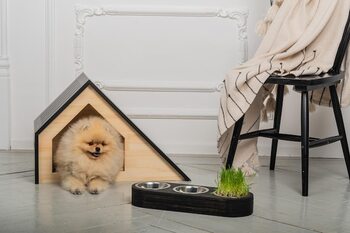Welcoming environments that promote play and exploration

Cozy environments that promote play and exploration are essential in pet-friendly homes. By creating spaces that stimulate curiosity and fun, we not only ensure the well-being of our pets but also transform our homes into havens of happiness. In this article, you will discover how to design environments that invite play and exploration, ensuring harmonious coexistence among all family members.
The importance of space: Why a cozy home benefits your pets?
The importance of space in a home cannot be underestimated, especially when it comes to our pets. A cozy and well-designed environment offers animals the opportunity to explore, play, and rest in a safe setting. Spaces that have designated areas for play, such as soft rugs or zones with specific toys, encourage physical and mental activity. This not only contributes to their physical well-being but also helps to reduce stress and anxiety, creating an emotional balance that is essential for a healthy life.
In addition, a cozy home promotes interaction between pets and their owners. By creating comfortable corners where both humans and animals can share moments together —such as spacious armchairs or sunbathing areas— the emotional bond is strengthened. Pets are social beings that thrive in environments where they can feel part of the family. A space designed for this purpose not only benefits our furry friends but also transforms our home into a more harmonious and fulfilling place for all its inhabitants.
2. Kid-friendly materials: Choosing play-resistant furniture and decorations.
When choosing furniture and decorations for a pet-friendly home, it is essential to opt for materials that are not only aesthetically pleasing but also functional and durable for play. Synthetic fabrics, such as polyester or acrylic, are excellent options due to their durability and easy cleaning. These materials can withstand scratches and stains, making them ideal allies for homes with curious and active pets. Additionally, furniture upholstered with these fabrics often comes in a variety of colors and patterns, allowing them to seamlessly integrate into the decor of any room.
Another important consideration is the choice of durable surfaces for tables and shelves. Treated wood or laminated finishes offer additional resistance to scratches and marks, while tempered glass tables are easy to clean. You can also consider modular furniture or those with rounded edges to avoid accidents during play. By carefully selecting these friendly materials, you not only ensure the longevity of your decorative pieces but also create a safe environment where both your pets and your family can enjoy without worries.
3. Play areas: Ideas for creating specific areas for your pets' entertainment.
To create effective and engaging play areas for your pets, it is essential to consider their specific needs and natural behaviors. You can designate an area in your home, such as a corner of the living room or a little-used room, where your furry friends can play freely. Equipping this space with interactive toys, scratching posts, and climbing platforms will not only keep them entertained but also allow them to exercise and develop motor skills. The incorporation of elements like non-slip rugs can add safety during their play sessions, while variety in toys will help prevent boredom.
You can also encourage exploration by creating a small maze or obstacle area using cardboard boxes or recycled furniture. These types of activities will not only stimulate their natural curiosity but also promote physical and mental activity. It is also important to keep this area clean and organized; this way your pets can fully enjoy without distractions or dangers. Remember to include nearby resting areas so they can relax after playing; it will be the perfect complement to a cozy environment that promotes both entertainment and tranquility in your pet-friendly home.
4. Visual stimuli: How to use colors and textures to capture your pet's attention.
Colors and textures are powerful tools in creating welcoming environments for our pets. By choosing vibrant color palettes, we can capture their attention and foster their curiosity. Warm tones like yellow, orange, or red not only bring energy to the space but can also stimulate active play. On the other hand, softer and neutral colors can provide a relaxing and cozy atmosphere, ideal for resting moments. It is essential to balance these color choices to create an environment that invites both exploration and tranquility.
Texture is another key element in the design of pet-friendly spaces. Incorporating different materials, such as soft rugs, plush cushions, or rough surfaces, can spark your pet's curiosity and encourage them to interact with their environment. Additionally, varied textures are not only pleasant to the touch but can also help define specific areas within the home: a soft blanket can indicate a comfortable place to rest, while an area with toys and intriguing textures can be seen as an active play zone. By appropriately combining bold colors with stimulating textures, we create a dynamic environment that not only attracts our pets but also enriches their daily experiences.
5. Nature indoors: Incorporating safe plants that encourage exploration.
Incorporating plants into the home not only beautifies the space but also provides our pets with a stimulating environment for exploration. By choosing safe plants, such as lavender, rosemary, or herbs, we can create green corners that invite animals to interact with their surroundings safely. These plants are not only harmless to them but also add pleasant aromas and freshness to the environment, contributing to a more welcoming home. Moreover, by allowing our pets to approach and play among the leaves and stems, we foster their curiosity and provide them with an enriching sensory experience.
The selection of plants can also be an opportunity to design creative play spaces within the home. For example, you can create a small indoor garden or an elevated shelf where pets can explore without fear of ingesting something toxic. Hanging planters can serve as fun obstacles and areas to climb, while vertical gardens offer varied textures that stimulate our pets' minds. This interaction with nature not only promotes physical exercise but also strengthens the bond between family members by sharing moments of discovery and play in a pleasant and safe environment.
6. Safety first: Tips to prevent accidents while your pet plays freely.
The safety of our pets should be a priority when creating welcoming environments for their play and exploration. To avoid accidents, it is essential to check the space for dangerous or sharp objects that may pose a risk. Make sure that the toys are suitable for their size and type, avoiding those that can break easily or have small parts that can be ingested. Additionally, consider using barriers or temporary fences in areas where you do not want your pet to have free access, such as the kitchen or the garage, as well as ensuring that windows and balconies are protected to prevent falls.
Another key aspect is to pay attention to the materials used in the decoration and furniture of the home. Choosing furniture that is resistant to stains and scratches can make living with your pets easier, while non-slip textiles will help prevent accidents during their antics. It is also advisable to always keep a basic pet first aid kit on hand, including supplies for small cuts or injuries. By following these guidelines, you can enjoy a safe home where both you and your furry companion can play and explore peacefully.
7. Family interaction: Fun activities that involve humans and pets.
Family interaction is a fundamental pillar to strengthen the bonds between household members, and when we include our pets in these activities, the fun multiplies. Planning game afternoons that involve both humans and animals can be an excellent way to encourage physical exercise and socialization. From simple fetch games to more elaborate treasure hunts throughout the house, each activity becomes an opportunity to create unforgettable memories. Furthermore, these dynamics not only mentally stimulate pets but also promote a greater emotional connection among all family members.
Incorporating play moments into the daily routine can transform an ordinary home environment into one filled with joy and vitality. Activities like basic training, where everyone participates in teaching tricks or commands to the pets, can be both educational and entertaining. Likewise, establishing movie nights where everyone cuddles up with their furry companions creates a sense of community and warmth. The key is to find activities that maintain the interest of both humans and pets, ensuring that each member of the household feels they have their place in the heart of a pet-friendly home.
8. Technology at the service of play: Gadgets and interactive toys to stimulate the minds of your furry friends.
In a world where technology is advancing rapidly, gadgets and interactive toys have become essential allies in stimulating the minds of our furry friends. From automatic treat dispensers to motion-responsive toys, these devices not only entertain our pets but also promote their mental and physical agility. By incorporating these elements into our homes, we create a dynamic environment that encourages animals to explore and play, keeping them active and happy while they have fun.
In addition to providing hours of fun, interactive toys can help prevent behavior problems associated with boredom. By providing mental challenges, such as puzzles that require pets to solve tasks to access a reward, we are stimulating their natural instincts for hunting and exploration. These play moments are not only beneficial for the emotional well-being of our furry friends but also strengthen the bond between them and their humans. Thus, by integrating innovative technology into the pet-friendly home, we transform every corner into a space full of opportunities to learn and play.
9. Inspiring testimonials: Real stories of homes transformed into happy spaces for pets.
Stories of homes that have been transformed into happy spaces for pets are a testament to the power of conscious design. Many families have shared how, by adapting their environments to the needs of their animals, they have not only improved the quality of life for their pets but also strengthened family bonds. For example, a couple decided to turn their small garden into a safe and stimulating play area for their dog. By installing a play tunnel and areas with different textures, they made each outing a unique adventure, full of exercise and fun that also allowed them to enjoy the outdoors together. These simple adaptations have led to a more harmonious and joyful coexistence in the home.
Another inspiring case is that of a family who transformed their living room into a multifunctional space where both humans and pets can enjoy. By creating cozy corners with low shelves for toys and soft blankets for resting, they achieved a warm environment where their cats can play and explore freely without sacrificing decorative style. This approach has allowed every family member to feel included and happy in their home. Stories like these demonstrate that with creativity and love, spaces can be designed that not only meet the physical needs of our pets but also foster memorable moments filled with joy and connection among all the loved ones in the home.



